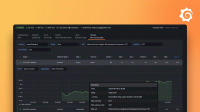Caution
Grafana Alloy is the new name for our distribution of the OTel collector. Grafana Agent has been deprecated and is in Long-Term Support (LTS) through October 31, 2025. Grafana Agent will reach an End-of-Life (EOL) on November 1, 2025. Read more about why we recommend migrating to Grafana Alloy.
Important: This documentation is about an older version. It's relevant only to the release noted, many of the features and functions have been updated or replaced. Please view the current version.
remote.http
remote.http exposes the response body of a URL to other components. The URL
is polled for changes so that the most recent content is always available.
The most common use of remote.http is to load discovery targets from an HTTP
server.
Multiple remote.http components can be specified by giving them different
labels.
Usage
remote.http "LABEL" {
url = "URL_TO_POLL"
}Arguments
The following arguments are supported:
| Name | Type | Description | Default | Required |
|---|---|---|---|---|
url | string | URL to poll. | yes | |
poll_frequency | duration | Frequency to poll the URL. | "1m" | no |
poll_timeout | duration | Timeout when polling the URL. | "10s" | no |
is_secret | bool | Whether the response body should be treated as a secret. | false | no |
When remote.http performs a poll operation, an HTTP GET request is made
against the URL specified by the url argument. A poll is triggered by the
following:
- When the component first loads.
- Every time the component’s arguments get re-evaluated.
- At the frequency specified by the
poll_frequencyargument.
The poll is successful if the URL returns a 200 OK response code. All other
response codes are treated as errors and mark the component as unhealthy. After
a successful poll, the response body from the URL is exported.
Blocks
The following blocks are supported inside the definition of remote.http:
| Hierarchy | Block | Description | Required |
|---|---|---|---|
| client | client | HTTP client settings when connecting to the endpoint. | no |
| client > basic_auth | basic_auth | Configure basic_auth for authenticating to the endpoint. | no |
| client > authorization | authorization | Configure generic authorization to the endpoint. | no |
| client > oauth2 | oauth2 | Configure OAuth2 for authenticating to the endpoint. | no |
| client > oauth2 > tls_config | tls_config | Configure TLS settings for connecting to the endpoint. | no |
| client > tls_config | tls_config | Configure TLS settings for connecting to the endpoint. | no |
The > symbol indicates deeper levels of nesting. For example, client > basic_auth refers to an basic_auth block defined inside a client block.
client block
The client block configures settings used to connect to the HTTP
server.
| Name | Type | Description | Default | Required |
|---|---|---|---|---|
bearer_token | secret | Bearer token to authenticate with. | no | |
bearer_token_file | string | File containing a bearer token to authenticate with. | no | |
proxy_url | string | HTTP proxy to proxy requests through. | no | |
follow_redirects | bool | Whether redirects returned by the server should be followed. | true | no |
enable_http_2 | bool | Whether HTTP2 is supported for requests. | true | no |
bearer_token, bearer_token_file, basic_auth, authorization, and
oauth2 are mutually exclusive and only one can be provided inside of a
http_client_config block.
basic_auth block
The basic_auth block configures basic authentication to use when polling the
configured URL.
| Name | Type | Description | Default | Required |
|---|---|---|---|---|
username | string | Basic auth username. | no | |
password | secret | Basic auth password. | no | |
password_file | string | File containing the basic auth password. | no |
password and password_file are mututally exclusive and only one can be
provided inside of a basic_auth block.
authorization block
The authorization block configures custom authorization to use when polling
the configured URL.
| Name | Type | Description | Default | Required |
|---|---|---|---|---|
type | string | Authorization type, for example, “Bearer”. | no | |
credential | secret | Secret value. | no | |
credentials_file | string | File containing the secret value. | no |
credential and credentials_file are mutually exclusive and only one can be
provided inside of an authorization block.
oauth2 block
The oauth2 block configures OAuth2 authorization to use when polling the
configured URL.
| Name | Type | Description | Default | Required |
|---|---|---|---|---|
client_id | string | OAuth2 client ID. | no | |
client_secret | secret | OAuth2 client secret. | no | |
client_secret_file | string | File containing the OAuth2 client secret. | no | |
scopes | list(string) | List of scopes to authenticate with. | no | |
token_url | string | URL to fetch the token from. | no | |
endpoint_params | map(string) | Optional parameters to append to the token URL. | no | |
proxy_url | string | Optional proxy URL for OAuth2 requests. | no |
client_secret and client_secret_file are mututally exclusive and only one
can be provided inside of an oauth2 block.
The oauth2 block may also contain its own separate tls_config sub-block.
tls_config block
The tls_config block configures TLS settings for connecting to HTTPS servers.
| Name | Type | Description | Default | Required |
|---|---|---|---|---|
ca_file | string | CA certificate to validate the server with. | no | |
cert_file | string | Certificate file for client authentication. | no | |
key_file | string | Key file for client authentication. | no | |
server_name | string | ServerName extension to indicate the name of the server. | no | |
insecure_skip_verify | bool | Disables validation of the server certificate. | no | |
min_version | string | Minimum acceptable TLS version. | no |
When min_version is not provided, the minimum acceptable TLS version is
inherited from Go’s default minimum version, TLS 1.2. If min_version is
provided, it must be set to one of the following strings:
"TLS10"(TLS 1.0)"TLS11"(TLS 1.1)"TLS12"(TLS 1.2)"TLS13"(TLS 1.3)
Exported fields
The following field is exported and can be referenced by other components:
| Name | Type | Description | Default | Required |
|---|---|---|---|---|
content | string or secret | The contents of the file. | no |
If the is_secret argument was true, content is a secret type.
Component health
Instances of remote.http report as healthy if the most recent HTTP GET
request of the specified URL succeeds.
Debug information
remote.http does not expose any component-specific debug information.
Debug metrics
remote.http does not expose any component-specific debug metrics.
Example
This example reads a JSON array of objects from an endpoint and uses them as a set of scrape targets:
remote.http "targets" {
url = env("MY_TARGETS_URL")
}
prometheus.scrape "default" {
targets = json_decode(remote.http.targets.content)
forward_to = [prometheus.remote_write.default.receiver]
}
prometheus.remote_write "default" {
client {
url = env("PROMETHEUS_URL")
}
}


